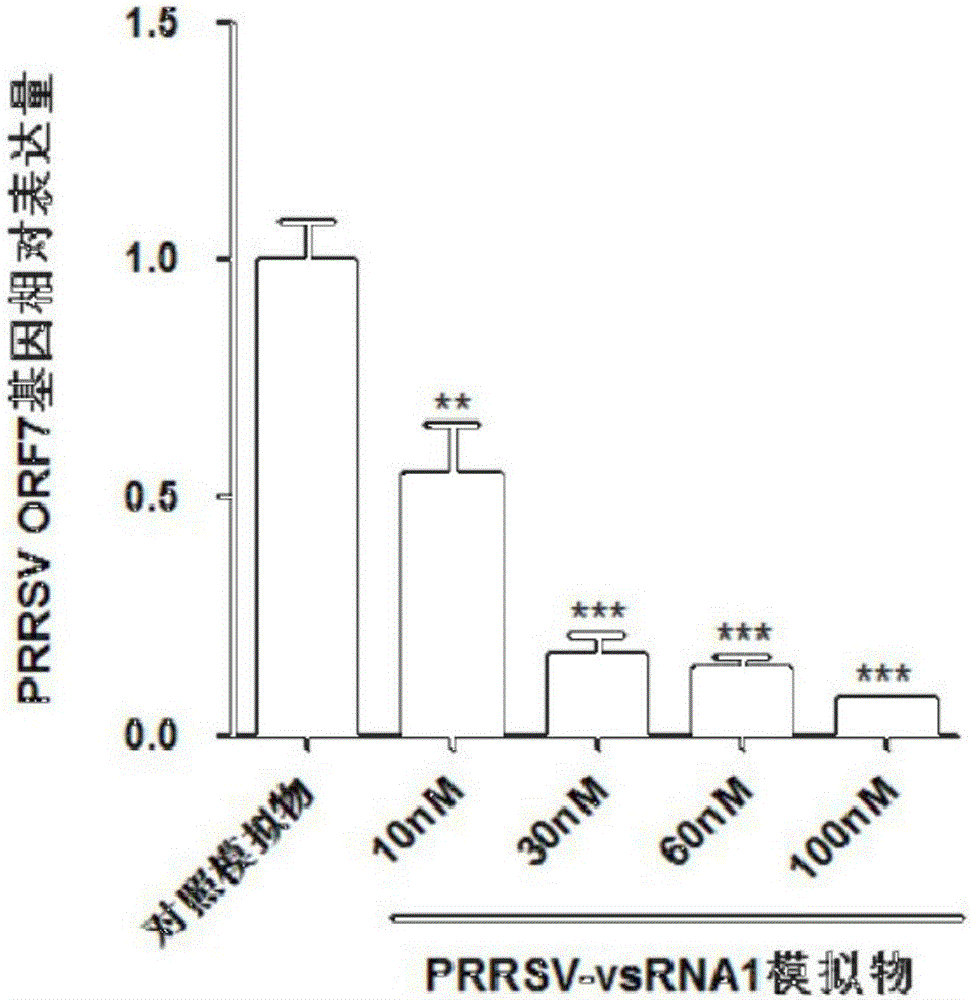Anti-PRRSV (porcine reproductive and respiratory syndrome virus) microRNA (ribonucleic acid)-like virus small RNA sequence and application and detection method thereof
A detection method and virus technology, applied in biochemical equipment and methods, DNA/RNA fragments, recombinant DNA technology, etc., can solve the problems of no anti-PRRS virus and limited protective effect, and achieve the effect of inhibiting PRRSV replication
- Summary
- Abstract
- Description
- Claims
- Application Information
AI Technical Summary
Problems solved by technology
Method used
Image
Examples
Embodiment 1
[0037] Example 1: Discovery of PRRSV-vsRNA1 and prediction of its structure
[0038] 1. Sequence download: from the miRBase website ( http: / / www.mirbase.org / ) to download all the reported microRNA mature sequences (Release 21: June 2014). From the NCBI website ( http: / / www.ncbi.nih.gov ) to download the PRRSV genome sequence (GenBank ID: KP793736.1).
[0039] 2. Prediction of the microRNA precursor sequence: use the python script program to divide the genome sequence of the GD-HD strain (GenBank ID: KP793736.1) into 1200 sequence fragments with a length of 90bp, and use RNAfold to perform hairpin secondary on the intercepted sequence Structural analysis and prediction of its MFE (minimum free energy), and then select an MFE less than or equal to -20Kcal.mol -1sequence as a potential microRNA precursor sequence. All the sequences were further identified by MiPred software, and the sequences matching the pre-microRNA were selected for BLASTn (nucleotide sequence alignment...
Embodiment 2
[0042] Example 2: Predict and identify target genes regulated by PRRSV-vsRNA1
[0043] 1. Use bioinformatics software to predict the target genes regulated by PRRSV-vsRNA1: first use the RNAhybrid website (http: / / bibiserv.techfak.uni-bielefeld.de / rnahybrid / ) to predict the potential target genes of PRRSV-vsRNA1 and their binding sites .
[0044] The specific method is to download the genome sequence of PRRSV strain GD-HD from the NCBI website, use the online prediction tool to upload the sequences of different gene regions of GD-HD and PRRSV-vsRNA1, and download the predicted binding sites and other information.
[0045] Comprehensively consider the following factors: the complementarity of the miRNA and the target site sequence; the conservation of the predicted target site in different strains; the thermal stability between the miRNA-mRNA duplex; there should be no complexities at the target site. secondary structure, etc.
[0046] The PRRSV genome encodes multiple non-str...
Embodiment 3
[0076] Example 3: Effects of PRRSV-vsRNA1 mimics of different concentrations transfected on PRRSV replication in PAMs cells
[0077] 1. PRRSV-vsRNA1 mimic transfection and cell inoculation:
[0078] 1) Plating: Isolate porcine alveolar macrophages from the lung tissue of 6-week-old piglets, perform cell counting and plating, and culture in a 5% CO2 incubator at 37°C;
[0079] 2) Transfection: The transfection reagent is Roche's X-tremeGENE siRNA Transfection Reagent, and the transfection is performed according to the operation steps of the transfection reagent. 12 hours after plating, a transfection mixture was prepared (the mock and siRNAtransfection reagent were dissolved in Opti-MEM respectively, and then the two were mixed) and incubated at room temperature for 20 minutes. Take the 24-well plate out of the incubator, wash it with PBS and replace it with Opti-MEM, add the mixture drop by drop, shake and mix well, and culture it in the cell culture incubator;
[0080] 3) I...
PUM
 Login to View More
Login to View More Abstract
Description
Claims
Application Information
 Login to View More
Login to View More - R&D Engineer
- R&D Manager
- IP Professional
- Industry Leading Data Capabilities
- Powerful AI technology
- Patent DNA Extraction
Browse by: Latest US Patents, China's latest patents, Technical Efficacy Thesaurus, Application Domain, Technology Topic, Popular Technical Reports.
© 2024 PatSnap. All rights reserved.Legal|Privacy policy|Modern Slavery Act Transparency Statement|Sitemap|About US| Contact US: help@patsnap.com










